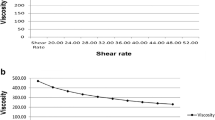Abstract
DA-5018, a recently synthesized capsaicin analog, appears to possess potent analgesic activity when administered topically. The objective of this study is to test the feasibility of the topical administration of this compound. Specifically, our goal was to identify vehicle system that permit a reasonable transdermal permeation of the compound in mice. Among the vehicles examined, isopropyl myristate (IPM) showed the largest in vitro permeability across the intact skin (83.6 ± 5.42 μl/cm2/h). However, due to the limited solubility of DA-5018 in IPM (0.53 mg/ml), the maximal flux from the IPM medium remained at only 44.3 ± 2.87 μg/cm2/hr. In order to increase the flux, addition of better solvents for DA-5018 was attempted, under the assumption that flux is the result of both solubility and permeability. Ethoxydiglycol (EG) and oleic acid (OA) were selected as examples of good solvents. The addition of EC or OA to IPM at a 1:1 volume ratio resulted in a comparable increase in the solubility of the compound (i.e., to 61.1 and 50.2 mg/ml for EG and OA, respectively). However, the addition of EG at a 1:1 volume ratio, for example, increased the flux 6.3 fold (i.e., 279 μg/cm2/hr), while OA, at a 1:1 volume ratio, decreased the flux 5 fold (i.e., 9.26 μg/cm2/hr). The mechanism of this discrepancy between EG and OA was investigated by measuring the permeabilty of DA-5018 across the stratum corneum-removed skin of the mouse, under the hypothesis that the viable skin layer may serve as a barrier for the permeation of lipophilic substances such as DA 5018. The permeability of DA-5018, from the medium of EG or OA, across the viable skin differed greatly for EC (0.41 μl/cm/hr) and OA (0.086 μl/cm2/hr), suggesting that a higher permeability across the viable skin layer is needed for the second solvents. The maximum flux across the intact skin was achieved for DA-5018 when EG was added to IPM at a 1:1 volume ratio. Thus, the use of a binary system appears to be the best approach for realizing the transdermal delivery of DA-5018 at a reasonable rate.
Similar content being viewed by others
References
Barry, B. W., Harrison, S. M., and Dugard, P. H., Correlation of thermodynamic activity and vapor diffusion through human skin for the model compound, benzyl alcohol.J. Pharm. Pharmacol., 37, 84–90 (1985).
Bennet, S. L., Barry, B. W., and Woodford, R., Optimization of bioavailability of topical steroids: non-occluded penetration enhancers under thermodynamic control.J. Pharm. Pharmacol., 37, 298–304 (1985).
Cha, B. J., Formulation study of cream for a new capsaicin derivative, N-3-(3,4-dimethylphenyl)propyl-4-(2-aminoethoxy)-3-methoxy phenyl acetamide. Ph. D. Thesis, College of Pharmacy, Seoul National University, 1998.
Chad, L. D., Thomas, J. S., Esther, L., James, R. S., Randall, M. S., Moise, D.L., Daniel, A., and Frederic, R., Treatment of arthritis with topical capsaicin. A double-blind trial.Clin. Then., 13, 383–395 (1991).
David, R. F., In vitro skin permeation technique.J. Cont. Rel., 18, 235–248 (1992).
Dugard, P. H. and Scott, R. C., A method of predicting percutaneous absorption rates from vehicle to vehicle: An experimental assessment.Int. J. Pharm., 28, 219–227 (1986).
Flynn, G. L. and Smith R. W., Membrane diffusion III: Influence of solvent composition and penetrant solubility on membrane transport.J. Pharm. Sci., 61, 61–66 (1972).
Hadgraft, J., Hadgraft, J. W., and Sarkany, L., The effect of thermodynamic activity on the percutaneous absorption of methyl nicotinate from water glycerol mixtures.J. Pharm. Pharmacol., 25(Suppl.) 122–123 (1973).
Levy, D. M., Abraham, R. R., and Tomlinson, D. R., Topical capsaicin in the treatment of painful diabetic neuropathy.N. Engl. J. Med., 14, 1176–1177 (1991).
Park, N. S., Ha, D. C., Choi, J. K., Kim, H. S., Lim, H. J., and Lee, B. Y., N-Aralkylated 4-(2-aminoethoxy) phenylacetamide derivatives as potent analgesic and antiinflammatory agents.Korean J. Med. Chem., 1, 36–43 (1991).
Shim, H. J., Lee, J. J. Lee, S. D., Kim, W. B., Yang, J., Kim, S. H., and Lee, M. G., Determination of a new non-narcotic analgesic, DA-5018, in plasma, urine and bile by high-performance liquid chromatography.J. Chromatogr., (in press).
Son, M. H., Bae, E. J., Kim, H. K., Shin, M. S., Kim, S. H., Kim, W. B., Yang, J., and Park, N. S., Analgesic effects of DA-5018, a new capsaicin derivative, against experimental acute pain.J. Appl. Pharmacol., 5, 67–73 (1997).
Tandan, R., Lewis, G. A., Krusinski, P. B., and Fries, T. J., Topical capsaicin in painful diabetic neuropathy: Controlled study with long-term follow-up.Diabetes Care, 15, 8–14 (1992).
Watson, C. P., Tylor, L. K., Bickers, D. R., Millican, L. E., Smith, S., and Coleman, E., A randomized vehicle-controlled trial of topical capsaicin in the treatment of post therapeutic neuralgia.Clin. Ther., 15, 510–526 (1993).
Author information
Authors and Affiliations
Corresponding author
Rights and permissions
About this article
Cite this article
Cha, B.J., Lee, E.D., Kim, W.B. et al. Enhanced skin permeation of a new capsaicin derivative (DA-5018) from a binary vehicle system composed of isopropyl-myristate and Ethoxydiglycol. Arch Pharm Res 24, 224–228 (2001). https://doi.org/10.1007/BF02978262
Received:
Issue Date:
DOI: https://doi.org/10.1007/BF02978262




